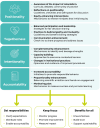Transforming partnerships through transboundary research
- PMID: 40216418
- PMCID: PMC11987111
- DOI: 10.1136/bmjgh-2024-017602
Transforming partnerships through transboundary research
Abstract
Research partnerships are a key entry point for addressing the asymmetries that pervade global health. However, highly competitive and fast-paced science limits the kind of innovation and transformative change needed to reduce the imbalances that undermine the independence and academic freedom of research partners. The goal of this piece is to present a transformative lens for partnerships in which participating research organisations are willing to be mutually influenced through genuine collaborative efforts. In contrast to transactional partnerships, a transformative collaboration identifies a set of goals toward which the partnership wishes to work and agrees on the process for achieving them together. First, reflexivity and awareness of positionality are needed to recognise the power relations embedded in research and how these relations may not serve all people equally. Second, solidarity and togetherness create an interconnected view that transcends differences. Third, collective reflection on how and why the desired changes will occur is needed to guide the planning of 'who will do what, how and when' to advance equity-centred actions. Finally, shared responsibility for actions and outcomes will ensure mutual trust and a productive working relationship among partners. Implementing these principles requires some partners to relinquish control and step back when necessary, others to take ownership and greater leadership, and all partners to act with solidarity, accountability and trust. These complementary attitudes underpin the success of transformative partnerships in realising the full societal value of global health research.
Keywords: Global Health.
© Author(s) (or their employer(s)) 2025. Re-use permitted under CC BY-NC. No commercial re-use. See rights and permissions. Published by BMJ Group.
Conflict of interest statement
Competing interests: None declared.
Figures





References
-
- Carbonnier G, Kontinen T. North-South Research Partnership: Academia Meets Development. European Association of Development Research and Training Institutes; 2014.
-
- Crane JT. Unequal ‘Partners’. AIDS, Academia, and the Rise of Global Health. Behemoth. 2010;3:3. doi: 10.1524/behe.2010.0021. - DOI
-
- Wegrich K. The blind spots of collaborative innovation. Public Management Review. 2019;21:12–20. doi: 10.1080/14719037.2018.1433311. - DOI
Publication types
MeSH terms
LinkOut - more resources
Full Text Sources
Medical
